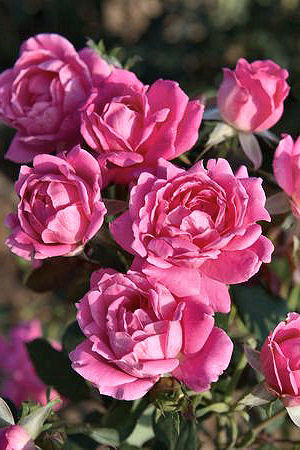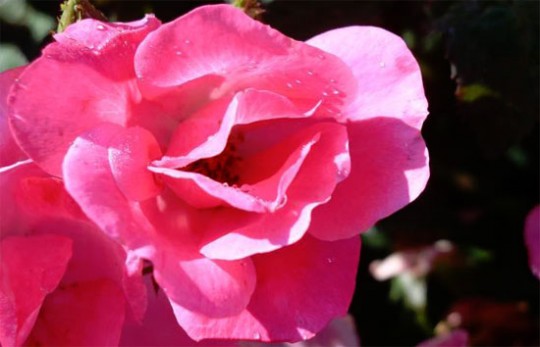Roses: A Knock Out Performer
August 28, 2010
Knock Out roses are the hottest plants to hit the market in years. Gardeners love these colorful shrub roses because they bloom profusely with minimal care.
 These shrub roses usually bloom like gangbusters for the first two to three years. Then, you may notice a decrease in their bloom set. But don’t despair; they may just need some attention.
These shrub roses usually bloom like gangbusters for the first two to three years. Then, you may notice a decrease in their bloom set. But don’t despair; they may just need some attention.
Remember that roses need three things to perform their best: sun, water and fertilizer.
All roses prefer full sun. They perform and bloom best with eight hours of direct sun daily. While Knock Out roses can survive with less, some people will push the limit and place them in shady areas of the landscape. Less sun will result in leggier plants with fewer blooms.
Roses need a lot of water during the warmer months, but they don’t like “wet feet”. When watering, try to keep the water off the foliage. Reducing the shrub’s exposure to overhead watering prevents leaf spot and disease.
Even though these roses are good, easy-to-grow plants, they still need properly prepared beds when planting. If your area does not drain well, consider improving drainage by making raised beds.
 The soil pH requirement for all roses is around 6.5. This indicates a slightly acid soil. Always follow recommendations of a soil test when modifying soil pH.
The soil pH requirement for all roses is around 6.5. This indicates a slightly acid soil. Always follow recommendations of a soil test when modifying soil pH.
Mulch your roses with pine straw or a similar organic material in spring and add new mulch in late summer or early fall. Two to three inches of mulch are great for roses.
Because Knock Out roses bloom so profusely, you may want to fertilize them regularly to keep them looking their best. Fertilize them with commercial rose food according to the product instructions. Water the soil thoroughly before you feed the roses to keep from burning the roots. Stop fertilizing late in the season so the plants can prepare to slow down or go dormant during the winter.
Sometimes low potassium (the third number on the fertilizer bag) can contribute to blooming problems. Differences in soil consistency may account for differences in plant responses to equal fertilization. Take soil samples to make sure your nutrient levels are appropriate in all flower beds.
Prune in mid-February by removing two-thirds of the plant’s height. Also, prune again late August to early September by removing about one-third of the shrub’s height. It is important to eliminate some older interior wood when pruning two to three year-old and older plants.
 Knock Out roses don’t have to be deadheaded. While not needing to deadhead roses is a good quality, it can also slow down the ability of the rose to bloom again quickly. If you want to keep your Knock Out roses blooming as often as possible, snip off the old blooms. Even though they will eventually drop their dead blossoms, you can get ahead of the game by helping them out.
Knock Out roses don’t have to be deadheaded. While not needing to deadhead roses is a good quality, it can also slow down the ability of the rose to bloom again quickly. If you want to keep your Knock Out roses blooming as often as possible, snip off the old blooms. Even though they will eventually drop their dead blossoms, you can get ahead of the game by helping them out.
Knock Out roses, as well as many other shrub-type roses, have five to seven bloom cycles between April and November. So take care of your plants properly, and you can enjoy blooms for the vast majority of the year.
Theresa Friday is the Residential Horticulture Extension Agent for Santa Rosa County.
Comments
One Response to “Roses: A Knock Out Performer”




Pretty!
It looks even better if you put rocks around them.